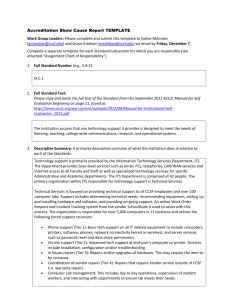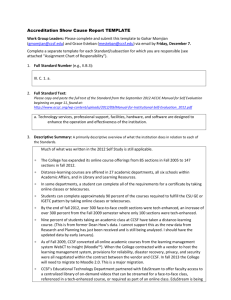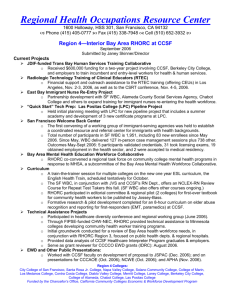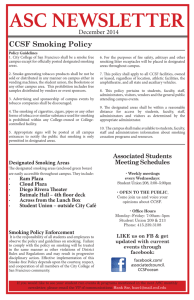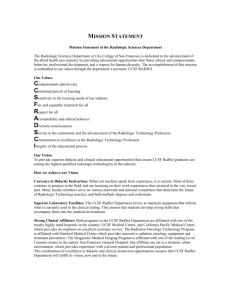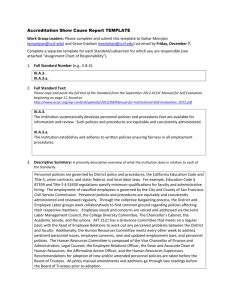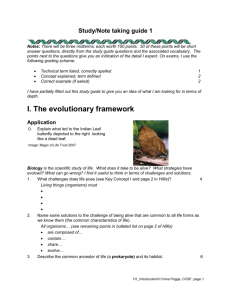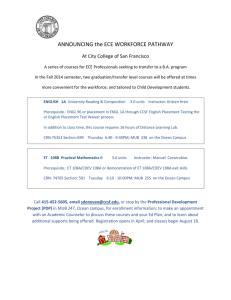Accreditation Show Cause Report TEMPLATE Work Group Leaders
advertisement
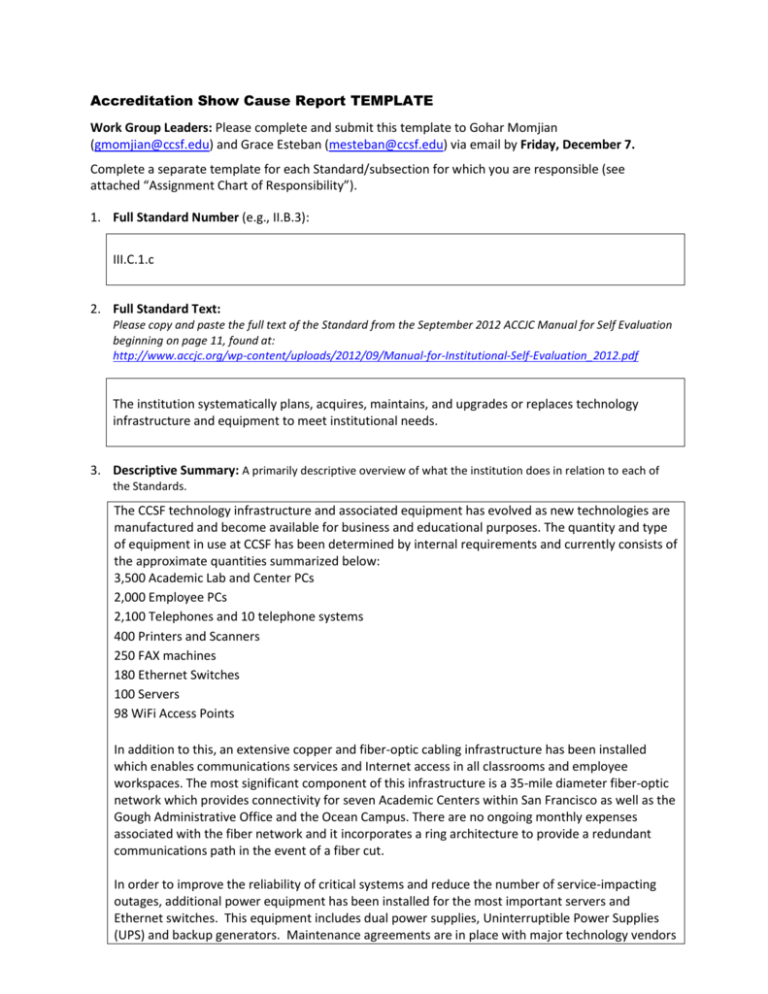
Accreditation Show Cause Report TEMPLATE Work Group Leaders: Please complete and submit this template to Gohar Momjian (gmomjian@ccsf.edu) and Grace Esteban (mesteban@ccsf.edu) via email by Friday, December 7. Complete a separate template for each Standard/subsection for which you are responsible (see attached “Assignment Chart of Responsibility”). 1. Full Standard Number (e.g., II.B.3): III.C.1.c 2. Full Standard Text: Please copy and paste the full text of the Standard from the September 2012 ACCJC Manual for Self Evaluation beginning on page 11, found at: http://www.accjc.org/wp-content/uploads/2012/09/Manual-for-Institutional-Self-Evaluation_2012.pdf The institution systematically plans, acquires, maintains, and upgrades or replaces technology infrastructure and equipment to meet institutional needs. 3. Descriptive Summary: A primarily descriptive overview of what the institution does in relation to each of the Standards. The CCSF technology infrastructure and associated equipment has evolved as new technologies are manufactured and become available for business and educational purposes. The quantity and type of equipment in use at CCSF has been determined by internal requirements and currently consists of the approximate quantities summarized below: 3,500 Academic Lab and Center PCs 2,000 Employee PCs 2,100 Telephones and 10 telephone systems 400 Printers and Scanners 250 FAX machines 180 Ethernet Switches 100 Servers 98 WiFi Access Points In addition to this, an extensive copper and fiber-optic cabling infrastructure has been installed which enables communications services and Internet access in all classrooms and employee workspaces. The most significant component of this infrastructure is a 35-mile diameter fiber-optic network which provides connectivity for seven Academic Centers within San Francisco as well as the Gough Administrative Office and the Ocean Campus. There are no ongoing monthly expenses associated with the fiber network and it incorporates a ring architecture to provide a redundant communications path in the event of a fiber cut. In order to improve the reliability of critical systems and reduce the number of service-impacting outages, additional power equipment has been installed for the most important servers and Ethernet switches. This equipment includes dual power supplies, Uninterruptible Power Supplies (UPS) and backup generators. Maintenance agreements are in place with major technology vendors for critical systems in order to ensure software upgrades and technical assistance is available as needed. Vendors which are contracted by CCSF for ongoing maintenance include Oracle, Elluician (formerly Sungard), Llilien LLC and Alcatel-Lucent. In addition to this, PCs purchased through the primary PC supplier, OmniPro, are covered by a 3-year warranty and Ethernet switches purchased through the primary supplier, HP Networks, are covered by a Lifetime Warranty. In past years the planning and acquisition of new and replacement equipment has not been entirely done on an Institutional basis. The ITS Department has provided centralized planning and implementation services to meet the equipment needs of Administrative Departments and employees (Faculty and Staff) using a combination of General Funds and Bond Funds from the 2001 and 2005 Bond measures. Academic Departments have used a combination of grant programs and other funding sources in order to meet the specific equipment needs of the academic programs. Academic departments that are part of the Career and Technical Education (CTE) program have been able to apply for Perkins funding in order to purchase new equipment for their specific needs. This process has met the needs of some departments but not others and has resulted in a nonuniform implementation and replacement method that lacks an Institutional-level funding process. It has also resulted in a situation where the Academic Lab PCs are in many instances much newer and faster than the Faculty and Staff PCs. In the future, to ensure a cohesive Institutional process, a centralized funding source will be allocated for all technology needs. ITS will continue to provide universally common technology services for Faculty, Staff, including a regular five-year replacement cycle for desktop PCs. The Program Review process will be utilized in order to perform an Institutional –level evaluation and prioritization of all other Administrative and Academic needs. The cost of implementing this process is estimated to be $1,130,000 annually and has been included in the CCSF Financial Plan beginning with FY2013-2014. This amount is in addition to the current ongoing ITS operations expenses which are approximately $1,135,000 annually and include only a small amount of funding for equipment replacement. The Perkins grant program for CTE programs is expected to continue in the future at some level, but a sufficient level of funding is being allocated in the Financial Plan independently of this program. Utilization of Academic Lab and Academic Center PCs will be measured in order to evaluate consolidation and sharing of resources across multiple departments and programs. Reliability of CCSF technology systems is provided by two primary methods. First, high quality products are selected to the greatest extent possible during the Request for Proposal (RFP) and subsequent acquisition process. Secondly, system redundancy and high-availability are included in the overall design strategy when feasible to include spare components and a mechanism for easy system replacement. Provisions are made for Disaster Recovery of critical systems by the CCSF ITS Department. This includes storing backup copies of key data offsite by utilizing the services of Iron Mountain, a leading company in the field of information management services. 4. Self Evaluation: Based on the descriptive summary, the institution should analyze and systematically evaluate its performance against the Eligibility Requirements, Accreditation Standards, Commission policies and its institutional mission. This analysis should result in actionable conclusions about institutional effectiveness and educational quality and decisions for improvement. The basic questions to explore are whether or not, and to what degree, institutional evidence demonstrates that the institution meets the Standards and how the institution has reached this conclusion. The Commission expects current and sustained compliance with the Standards, focusing on accomplishments and outcomes that have been achieved and not just structures or processes used. CCSF partially meets this Standard Evidence: System Maintenance Documents Evidence: Future Fiscal Year Technology Costs Evidence: Career and Technical Education (CTE) information: http://www.ccsf.edu/NEW/en/educational-programs/career-and-technical-education/facultyresources/perkins-funding-news.html Evidence: Perkins CTE Allocations FY2007-2012 Evidence: Program Review information: http://www.ccsf.edu/NEW/en/employee-services/research-planning-andgrants/planning/program_review.html Evidence: Annual Assessment, Planning and Budgeting Timeline Evidence: CCSF 2013-2015 Technology Plan Future Requirement: A complete Disaster Recovery strategy requires a thorough definition and allocation of appropriate resources. Future requirement: Ensure Program Review completed as designed Future requirement: Ensure funding allocated as budgeted Future Requirement: Align dates of Perkins funding process with Program Review 5. Actionable Improvement Plans: Continuous quality improvement is a hallmark of institutional effectiveness. As an institution evaluates its programs and services with reference to each Standard, it identifies areas in need of change. The Commission expects the institution to identify goals related to the areas that require change and decide on the action required to meet these goals. The institution should include the required actions in improvement plans. It may not be possible for the institution to have improvement plans fully developed at the time of submission of the Institutional Self Evaluation Report. The Commission expects these actionable improvement plans to be integrated into the institution’s continuous evaluation and planning processes. Please provide a narrative summary of the goals and associated actions in the text box below: Disaster Recovery Strategy and Process Ensure Program Review completed as designed Ensure funding allocated as budgeted Align dates of Perkins funding process with Program Review Please complete the table below to summarize the goals and actions described above as concisely as possible (add rows as needed): Goal Disaster Recovery Strategy and Process Ensure Program Review completed as designed Ensure funding allocated as budgeted Align dates of Perkins funding process with Program Review Associated Action(s) Expected Completion Date Disaster Recovery Plan December 31, 2013 Program Review (annually) May 1, 2013 CCSF Financial Plan (annually) July 1, 2013 Align Perkins Funding Process December 31, 2013
